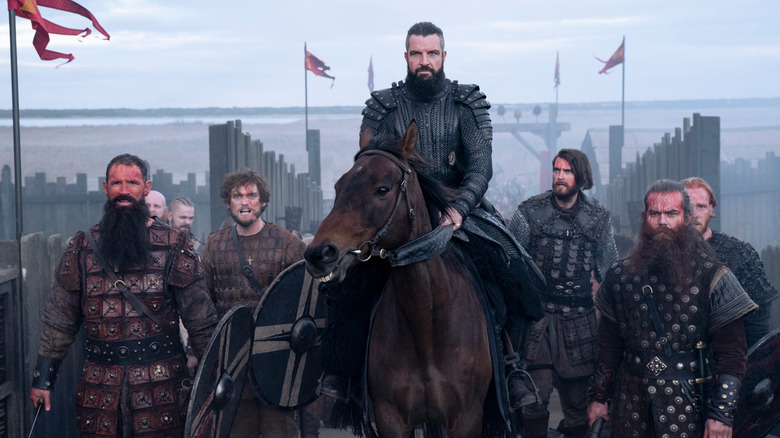The White Flag Scene In Vikings: Valhalla Episode 4 Explained
Contains spoilers for "Vikings: Valhalla," Season 1, Episode 4, "The Bridge"
In the fourth episode of the inaugural season of "Vikings: Valhalla," we see the first interaction between King Canute's (Bradley Freegard) Viking army and the newly crowned King Edmund's (Louis Davison) English army. Before there was an epic battle filled with swords, shields, bows and arrows, and horses, Canute allows Edmund to avoid bloodshed by way of surrender or man-to-man combat.
Of course, there is no way an arrogant king would avoid the opportunity to display his battlefield prowess by surrendering. So Edmund opens the gates and charges his men across the bridge, only to discover it is a trap. Leif Eriksson (Sam Corlett) hides under the bridge and weakens the supports with his warriors by chopping them thinly with their axes. They proceed to tie ropes around the base supports of the bridge, and Olaf Haraldsson (Johannes Haukur Johannesson) captains his boats to pull the bridge down, effectively cutting the young English king off from the safety of his castle.
However, it is the cunning use of a white flag that allows King Canute to speak to King Edmund and coerce him out of his castle. How does he do this? And is it historically accurate?
Is it false surrender or parley?
As far as cinematic storytelling goes, this tactic allows viewers the opportunity to witness the exchange between two leaders. Can you imagine "Braveheart" without the fantastic interactions between William Wallace and the English on the battlefield? This use of the flag sets up the scene for King Canute to goad King Edmund into a confrontation, threatening his manhood and ability on the battlefield. In return, the audience was treated to the superb acting skills of Louis Davison when he reacted with anger, disgust, and ultimately disastrous impetuousness. But is it historically accurate beyond the cinematic value of the white flag?
According to History, the use of the white flag goes back thousands of years to the Second Punic War, where a Carthaginian ship adorned with white wool and olive branches was used as a symbol of parley — an opportunity for leaders and generals to meet on the battlefield to discuss terms and hopefully avoid killing each other. The belief is that a blank flag was easier to discern on a battlefield and since such flags were made of simple white wool, it was an affordable way to signify surrender or parley. While modern-day governments labeled it in the Geneva and Hague Conventions as a symbol for those things, the white flag can also be traced back to Han Dynasty as a representation of death and mourning in China.
So in the case of "Vikings: Valhalla," King Canute's use of the flag both allowed for a poignant moment between him and his enemy and was able to do so without compromising historical accuracy. As it seems, the History Channel knows what they are doing when it comes to historical epics.

